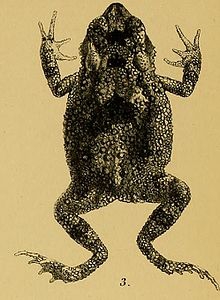| Citation |
IUCN SSC Amphibian Specialist Group. 2017. Ingerophrynus macrotis. The IUCN Red List of Threatened Species 2017: e.T54699A113955971. https://dx.doi.org/10.2305/IUCN.UK.2017-2.RLTS.T54699A113955971.en. Downloaded on 09 September 2020. |
Description |
JUSTIFICATION
Listed as Least Concern as this species is relatively widespread, with an estimated extent of occurrence (EOO) of 3,180,415 km2.
RANGE DESCRIPTION
This species is known from between approximately 50–650 m Asl in Arunachal Pradesh in Northeastern India (Borah and Bordoloi 2002, Sarkar and Ray 2006, Matthew and Sen 2010) and across most of mainland Southeast Asia including Myanmar (Boulenger 1887, Wogan et al. 2008), Thailand (Taylor 1962, Chan-ard 2003), Peninsular Malaysia (Berry 1975), Cambodia (Ohler et al. 2002), Lao PDR (Stuart 2005) and Viet Nam (Inger et al. 1999, Bain et al. 2007, Nguyen et al. 2009, Luu et al. 2014). These may not represent the actual limits of the species range as similar habitat and elevations to those in the species known localities extend into adjacent parts of southern China. Further surveys in these areas may uncover its presence there, therefore its range has been projected beyond known sites to include these areas of suitable habitat. The species estimated EOO is 3,180,416 km2, which represents 14 threat-defined locations.
DESCRIPTION
There are no estimates of the size of this species population, however it has been detected in a number of surveys (e.g. Boulenger 1887, Taylor 1962, Inger et al. 1999, Borah and Bordoloi 2002, Ohler et al. 2002, Stuart 2005, Sarkar and Ray 2006, Bain et al. 2007, Luu et al. 2014), and has been described as abundant in protected areas (Annemarie Ohler and Jeremy Holden pers. comm. March 2012). Further surveys are warranted to determine its relative abundance. Habitat loss associated with expanding agriculture in parts of this species range (Sodhi et al. 2009) may be causing population declines.
HABITAT AND ECOLOGY
This species is associated with a range of habitats including both evergreen (Stuart 2005, Bain et al. 2007) and deciduous (Stuart 2005) forest, forested karst environments (Luu et al. 2014), and grasslands (Stuart 2005, Matthew and Sen 2010) including floodplains (Stuart 2005). It is also known to occur in drier areas, albeit at lower densities than in forests (Annemarie Ohler and Jeremy Holden pers. comm. March 2012). Habitat in a considerable portion of the species range has been degraded by conversion to agricultural land (Sodhi et al. 2009). In Thailand, the species has been observed to reproduce in July and August (Taylor 1962). It is an explosive breeder, and during breeding aggregations around small forest streams, the skin of males has been observed to become comparatively smooth and yellow (Taylor 1962).
THREATS
Habitat loss and degradation due to rapidly expanding agriculture is an ongoing threat to biodiversity throughout Southeast Asia (Sodhi et al. 2009). In the Central Highlands of Viet Nam, this is particularly pressing; large areas of forest are converted to agricultural land to grow cash crop plantations (e.g. rubber, coffee and tea) (Meyfroidt and Lambin 2008, Meyfroidt et al. 2013). High rates of deforestation for logging, and agricultural encroachment on natural forest are also ongoing in much of Lao PDR and Cambodia (Sodhi et al. 2009). Other causes of habitat loss in Cambodia are the illegal removal of certain tree species for the harvest and refinement of safrole oil, as well as increasing human settlement, both of which are ongoing within protected areas (Ohler et al. 2002, Bradfield and Daltry 2009). This species is very likely threatened to some degree by habitat loss. Fires could also be a threat to the species in some of the drier areas of its range (Annemarie Ohler and Jeremy Holden pers. comm. March 2012), however this may also serve to provide new habitat in the medium- to long-term (Jeremy Holden pers. comm. March 2012).
USE AND TRADE
There are no reports of this species being utilized.
CONSERVATION ACTIONS
Conservation Actions
This species is known from a number of protected areas including Dong Khanthung National Biodiversity Conservation Area in Lao PDR (Stuart 2005) and Phong Nha - Ke Bang National Park in Viet Nam (Luu et al. 2014). Its predicted range includes a large number of other protected areas throughout Southeast Asia and northeast India; it very likely occurs in some of these also. The species is protected by law in Thailand under the Wild Animals Reservation and Protection Act 1992.
Research Needed
In order to ensure the species long-term survival, the lack of data must be addressed; research should be carried out to determine its relative abundance and threats. |

